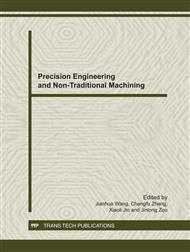p.331
p.335
p.339
p.344
p.349
p.357
p.361
p.365
p.370
Forming Shape of Narrow Groove Machined by Electro Jet Machining
Abstract:
In order to study small size three dimensional shape processing of electro jet machining, the micro-channel principle is introduced firstly. Moreover, narrow groove processing experiment design and construction process is described, and experimental purpose is to change the cycle times to research the rule of groove width and depth. The experimental results indicate that when the width of the groove reaches a certain value, it will be stabilized and fluctuate around the value. However, with the increasing of the cycle number, groove depth increases. If cycle times are less than 7, the overall shape of the groove is a part of an approximate ellipse, otherwise it is changed but the bottom shape of the groove is still a part of an approximate ellipse.
Info:
Periodical:
Pages:
349-353
Citation:
Online since:
November 2011
Authors:
Keywords:
Price:
Сopyright:
© 2012 Trans Tech Publications Ltd. All Rights Reserved
Share:
Citation:


